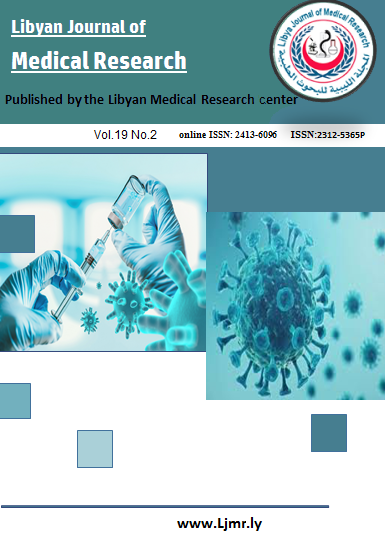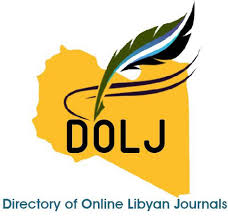Prevalence and Determinants of Consanguinity among the Libyan Population in Misurata as an Important Family and Child Health Issue
DOI:
https://doi.org/10.54361/LJMR.19.2.31Keywords:
Consanguinity, Misurata, Libya, Genetic Disorders, Consanguineous MarriageAbstract
Background: Consanguineous marriage is a deeply rooted cultural practice in many Mediterranean and Middle Eastern populations, including Libya, and it plays a significant role in the burden of genetic diseases and public health. The aim of this study was to estimate the prevalence and patterns of consanguineous marriages in Misurata, Libya, and to assess their potential role in increasing the risk of inherited disorders. Material and Methods: A cross-sectional survey was conducted from May to June 2025 at zero-dose vaccine centers in Misurata. A total of 500 fathers accompanying their children for vaccination were interviewed using a structured, pre-tested questionnaire that gathered information on demographic characteristics, marital relationships, and consanguinity status. Results: Out of the 500 couples, consanguinity was observed in 180 cases (36%), including paternal first cousins (8.6%), maternal first cousins (6.8%), double first cousins (2.6%), second cousins from the father’s side (3.8%) and mother’s side (3.4%), and more distant relatives (10.8%). The average age was 31.4±6.9 years for wives and 39.7±7.9 years for husbands. A family history of inherited disease was reported in 9.6% of the couples. Conclusions: Consanguineous marriages, especially first-cousin unions, remain highly prevalent in Misurata. Targeted genetic counseling, culturally sensitive awareness programs, and updated research are urgently needed to reduce the incidence of inherited disorders in the Libyan population.
Downloads
References
1. Tadmouri G, Nair P, Obeid T, et al. Consanguinity and reproductive health among Arabs. Reprod Health. 2009;6:17. doi:10.1186/1742-4755-6-17
2. Nussbaum RL, McInnes RR, Willard HF. Thompson & Thompson genetics in medicine. 8th ed. Philadelphia: Elsevier/Saunders; 2016. p. 110.
3. Romdhane L, Mezzi N, Hamdi Y, et al. Consanguinity and inbreeding in health and disease in North African populations. Annu Rev Genomics Hum Genet. 2019;20:155-79.
4. Younis M, Sasikala K, Anand AV, et al. Genetic analysis, health issues and consanguineous marriage in Muslim community. Int J Sci Res Sci Technol. 2018;4(2):100-7.
5. Hamamy H, Antonarakis SE, Cavalli-Sforza LL, et al. Consanguineous marriages, pearls and perils: Geneva International Consanguinity Workshop report. Genet Med. 2011;13(9):841-7.
6. Bittles AH, Black ML. Consanguinity, human evolution, and complex diseases. Proc Natl Acad Sci U S A. 2010;107 Suppl 1:1779-86.
7. Ben Arab S, Masmoudi S, Beltaief N, et al. Consanguinity and endogamy in Northern Tunisia and its impact on non-syndromic deafness. Genet Epidemiol. 2004;27(1):74-9.
8. Saba N, Kumar J, Kumar A, Balwan WK. Keeping it in the family: consanguineous marriages. Turk J Physiother Rehabil. 2022;32(3):38872-9.
9. Aissaoui F. Consanguineous marriage between Sharia, law and medicine. J Law Sustain Dev. 2024;12(8):e03887.
10. Al-Gazali H, Hamamy S, Al-Arrayad S. Genetic disorders in the Arab world. BMJ. 2006;333(7573):831-4.
11. Alghamdi S, Alzahrani F, Alsaedi R, et al. The impact of consanguinity on developmental disorders in Saudi Arabia: a cross-sectional study. BMC Med Genet. 2023;24(1):28.
12. Bensalem M, Bouzid T, Maamri R. Patterns of consanguinity and reproductive health in rural Algeria. North Afr J Genet. 2021;5(2):45-52.
13. Romdhane L, Mardassi H, Abdelhak S. Homozygosity and recessive disease risk in Tunisian consanguineous families: a genome-wide analysis. Genomics Hum Genet Rep. 2022;13(1):113-22.
14. El Mouzan MI, Al Salloum AA, Al Herbish AS, et al. Consanguinity and major genetic disorders in Gulf populations. J Community Genet. 2020;11(4):517-25.
15. Khatib N, Al-Quraan L, Abojaradeh A. Attitudes toward consanguineous marriage among university students in Jordan: a cross-sectional study. J Biosoc Sci. 2021;53(5):803-11.
16. Hamamy H, Al-Gazali L, Al-Arrayad S. National screening programs and the prevention of genetic disorders in Arab countries. East Mediterr Health J. 2022;28(3):235-42.
Downloads
Published
Issue
Section
License
Copyright (c) 2025 Maryem Elbashir Ismail, Fatheia Ahmed Elrishi, Muftah Elbahloul, Osama H. Almajub, Malak Emad Elgubbi, Fatma Faraj Elsaghayer, Fatima Meftah alzalouk, Esraa Mahjoub Shagroun, Tasneem Mustafa Shaneshah (Author)

This work is licensed under a Creative Commons Attribution-NonCommercial-NoDerivatives 4.0 International License.
Open Access Policy
Libyan journal of medical Research (LJMR).is an open journal, therefore there are no fees required for downloading any publication from the journal website by authors, readers, and institution.
The journal applies the license of CC BY (a Creative Commons Attribution 4.0 International license). This license allows authors to keep ownership f the copyright of their papers. But this license permits any user to download , print out, extract, reuse, archive, and distribute the article, so long as appropriate credit is given to the authors and the source of the work.
The license ensures that the article will be available as widely as possible and that the article can be included in any scientific archive.
Editorial Policy
The publication of an article in a peer reviewed journal is an essential model for Libyan journal of medical Research (LJMR). It is necessary to agree upon standards of expected ethical behavior for all parties involved in the act of publishing: the author, the journal editorial, the peer reviewer and the publisher.
Any manuscript or substantial parts of it, submitted to the journal must not be under consideration by any other journal. In general, the manuscript should not have already been published in any journal or other citable form, although it may have been deposited on a preprint server. Authors are required to ensure that no material submitted as part of a manuscript infringes existing copyrights, or the rights of a third party.
Authorship Policy
The manuscript authorship should be limited to those who have made a significant contribution and intellectual input to the research submitted to the journal, including design, performance, interpretation of the reported study, and writing the manuscript. All those who have made significant contributions should be listed as co-authors.
Others who have participated in certain substantive aspects of the manuscript but without intellectual input should only be recognized in the acknowledgements section of the manuscript. Also, one of the authors should be selected as the corresponding author to communicate with the journal and approve the final version of the manuscript for publication in the LJMR.
Peer-review Policy
- All the manuscripts submitted to LJMR will be subjected to the double-blinded peer-review process;
- The manuscript will be reviewed by two suitable experts in the respective subject area.
- Reports of all the reviewers will be considered while deciding on acceptance/revision or rejection of a manuscript.
- Editor-In-Chief will make the final decision, based on the reviewer’s comments.
- Editor-In-Chief can ask one or more advisory board members for their suggestions upon a manuscript, before making the final decision.
- Associate editor and review editors provide administrative support to maintain the integrity of the peer-review process.
- In case, authors challenge the editor’s negative decision with suitable arguments, the manuscript can be sent to one more reviewer and the final decision will be made based upon his recommendations.














